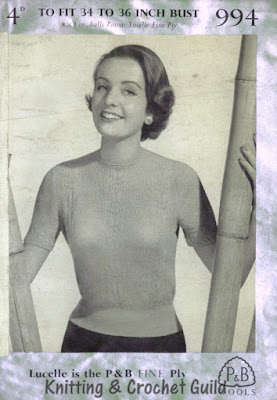I also wanted to try out the lace pattern in one of the jumper patterns. The leaflet calls it a "Shetland-pattern jumper" and it has three lace panels on the front and one around the bottom of each sleeve.
 |
| Patons 994 |
As I said in my earlier post, the main part of the jumper was intended to be knitted on size 16 needles (1.6mm.), with the rib on size 17s (1.4mm.). The smallest needles I have are 14s (2mm.) but I decided for a swatch it wouldn't matter. Knitting an entire garment on size 16s would be a daunting prospect, even though it has short sleeves, is only designed for a smallish size (34-36in. bust) and is quite short (19¾ in., or 50cm.).
I had assumed that, apart from the lace panels, the jumper was knitted in stocking stitch, but got an unpleasant surprise on reading the instructions - the background is a lace mesh stitch pattern. Barbara Walker calls it 'Star rib mesh' in her book A Treasury of Knitting Patterns. It's a 4-row repeat, and on alternate rows you just purl, so it's relatively simple. Even so, it's a lot harder than stocking stitch. I certainly wouldn't ever be able to knit it without watching what I was doing, as I can with stocking stitch.
The main lace stitch, in the panels, is much more complicated. It's a 40-row repeat, for one thing - though again, on wrong side rows you just purl. (I might have given up otherwise.) What's more, the number of stitches changes constantly. You start with 23 stitches, but sometimes you have as many as 31 stitches, and other times it goes down to 17 stitches. Which is pretty crazy.
After I had done the first pattern repeat, plus a few more rows, I was a bit puzzled about what it was supposed to look like. (I made a small mistake half way up - it's supposed to be completely symmetrical. But apart from that, I followed the instructions correctly, I assure you.) There are some things that might be intended to look like leaves, and some smaller shapes that might be petals? or smaller leaves? Altogether it doesn't make much sense to me.
So I went back to the pattern leaflet and had a closer look.
I thought that in some places, the photo seemed to show two leaves, a four-petalled flower, and some smaller leaves either side. Hard to tell. It looked as though there perhaps should be a central disc in the middle of the four 'petals' - like a sort of daisy. So for the second pattern repeat, I changed one row of the pattern to make it look more flower-like.
I don't know. It's quite pretty, I suppose, but I'd like it to look a bit less random. And it is much too much work to want to repeat it.
Here's my complete swatch. I do at least now have something to demonstrate what Lucelle is like when it's knitted up. I do wonder, though, whether anyone ever knitted this jumper, apart from the sample knitter. Who was, I hope, paid more than the usual rate for it.




That's a very pretty jumper, though it's definitely one for someone with a lot of time on their hands.
ReplyDeleteYes, though when you think of how much work housewives had to do in those days, you do wonder who were all these women knitting with 2-ply and finer. And since houses were generally colder than they are now, why didn't they knit something warmer anyway?
DeleteIt looks like Lily of the valley to me!
ReplyDeleteI hadn't thought of that. It doesn't look very like to me, but perhaps it is meant to.
DeleteThis is fascinating and I do admire your patience. I also wonder who was actually knitting these very fine complicated patterns. I was born in 1951 and my mother and grandmother were avid knitters. The yarns they used were mainly 4 ply or 3 ply, even for large-sized men's sweaters and they certainly weren't scared of fairly fancy stitches, whether lacy or cable. However I think they would have found a jumper like this rather frivolous and a waste of time. I have a few knitting books from the 1940s and 50s, some of which have very elaborate underwear sets in 2 ply yarns. I can't believe many people invested the time in creating these, however beautiful.
ReplyDeleteI only had enough patience for a small swatch... I think it's understandable that women knitted with very fine yarns in the 1940s because wool rationing (up to 1949) meant that you had to make a little wool go a long way, but I don't know why they didn't knit in thicker wools as soon as they could.
DeleteThicker knitting wools were in use before the war, after all. It's a mystery.